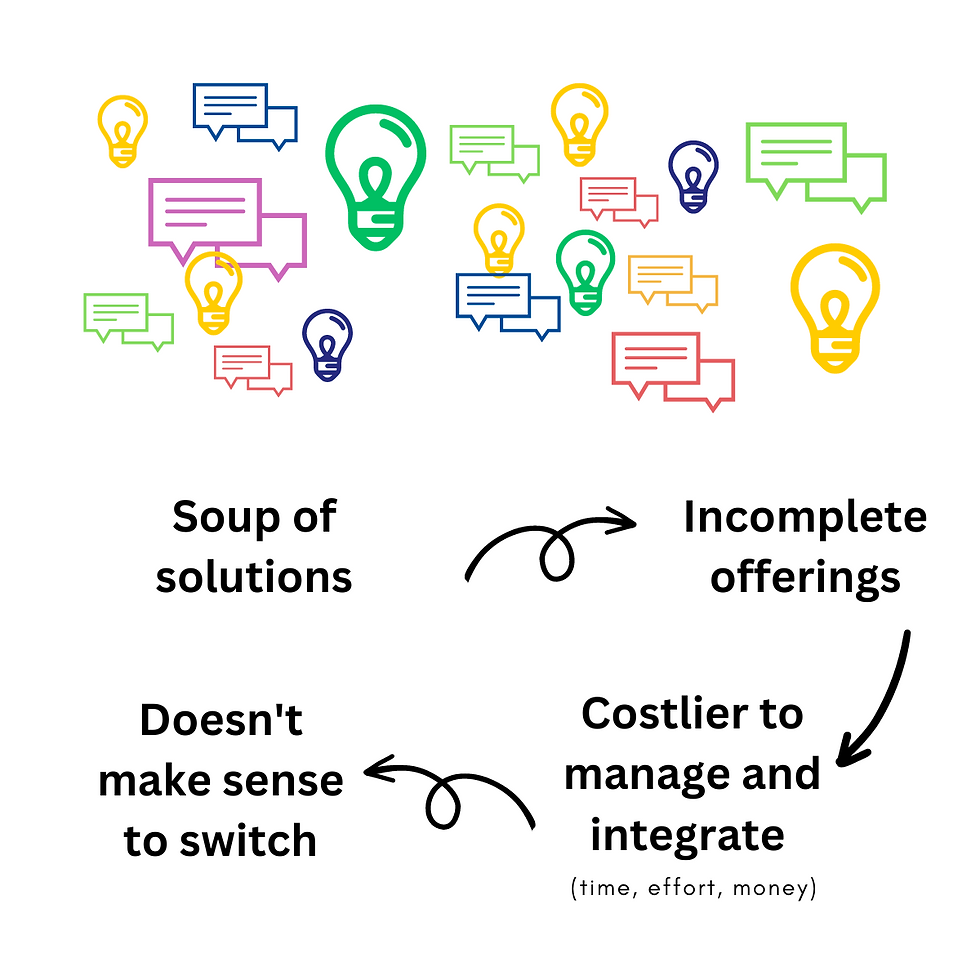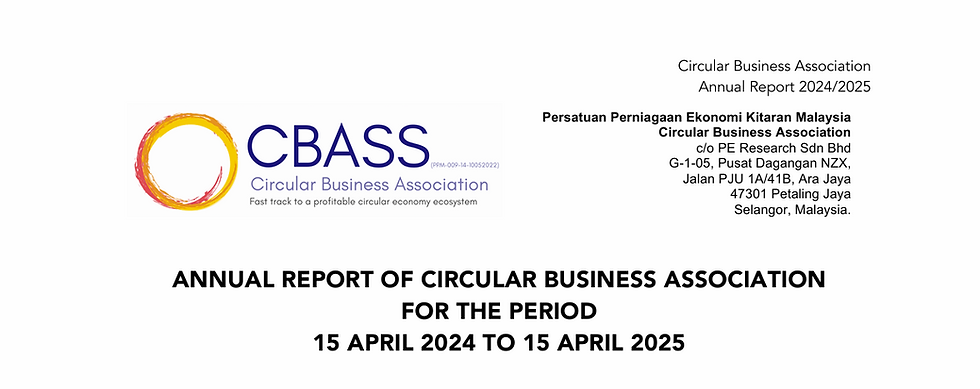Climate Movement 2.0 is needed (and it's not about a 'noble cause')
- lijinchin
- Mar 26, 2023
- 6 min read

Four days ago on 19 Mac 2023, the Intergovernmental Panel on Climate Change (IPCC) released the Synthesis Report for the Sixth Assessment Report.
Their press release was titled...
"Urgent climate action can secure a liveable future for all".
LIVEABLE. Yup, sounds about right. (as to why even bother about climate)
And the warning was clear...
"The pace and scale of climate action are insufficient to tackle climate change".
INSUFFICIENT. PACE. SCALE.
Yup, sounds about right too. (about the current state of climate action)
So, obviously the path forward is to UP THE SCALE AND PACE of climate action (as you can see from the presentation deck, IPCC agrees too).

So, WHY hasn't it already happened?
This question always crops up. Every time we see a short reel about new technological advancements that could solve the climate problem. Every time we read about funds that are channeled to a local or regional climate programme. Every time we read about the devastating consequences of climate change.
Every. Single. Time.
And after more than 50 years of climate action in one way or another - be it via NGO, conservation, activism, public policy, international development projects, academics, business ... It is increasingly clear that Climate Movement 1.0 has run its due course and it is time to MOVE ON.
Why has Climate Movement 1.0 failed?
'Failed' is perhaps too strong a word. After all, the action takers today in sustainability and climate have been born from Climate Movement 1.0. It has been an essential part of our journey. It has helped us understand, connect and imagine how the future could be. But the fact is, that it has been ineffective to solve the climate situation as evidenced by the fact that we are still in this predicament.
So the question is,
"Will Climate Movement 1.0 be enough to get us through the climate crisis?"
Unfortunately, the answer is most probably "No."
Why?
1. It does not directly address the issue of livelihoods
" I may know that living like this cannot work for long for all of us, but what is the alternative? If there is no alternative for the me that is struggling now, how can you crucify me for wanting to find a way to live?"
This is a fundamental clash that Climate Movement 1.0 has when it comes to increasing pace and scale. The common narrative paints climate action as 'a noble cause', 'socially responsible' while consumption and profit-making is coined as 'capitalism', 'selfish', 'impure intentions' and 'the root of all problems'.
Yet, by default, people will always strive to live the lives they want. But livelihoods cannot be supported by relying on donations, charity, voluntary contributions alone. After all, even donors and contributors had to find a way to gather the resources themselves before they could share. Moreover, 'Choice' is often set within the ecosystem conditions that people face.
The 'noble cause' narrative of Climate Movement 1.0 is limiting itself from drawing the resources is needs to gather scale and pace because it fails to answer "How will people make a living in this idealised concept of taking climate action?"
So, continuing to hammer people for not taking more climate action without building an alternative model that can enable their living does little to gather pace or scale. On the contrary, the downplaying of the 'selfish intent' within the Climate Movement 1.0 narrative is limiting its ability to draw the resources to expand impact beyond projects and local action. Not to say that these levels are unimportant, but we really need more scale, quickly, right now.
2. It focuses on verticals instead of systems.
Climate Movement 1.0 tends to inherit the ineffective sector-, industry- or vertical-focus of the existing economic system when designing solutions. For example, the waste sector, the automobile industry or the technology for carbon capture.
The problem lies in that the vertical-focus is too silo-ed to solve problems faced by users in totality, be it for businesses or individuals. Solutions are often standalone products that need to be integrated with other products and services to truly reach its optimal performance. This translates to a soup of incomplete market offerings that are costlier in money, time and effort to manage and integrate. So the 'tried and tested' options may be there, but they cannot gain enough market share or scale to significantly impact the climate situation.

For example, a product with recyclable content is actually not recyclable if there is no logistics infrastructure to collect nor technology that is economically viable to recover those materials. But from the industry perspective, they have already achieved their role by manufacturing a product with recyclable content and it is now the logistics or waste sector to deal with it.
This silo-ed response is worsened by the narrative of Climate Movement 1.0 because motivations for taking more action is just as a 'social responsibility' and not because they can identify and monetise such values that are spread across the overall system. Drawing example from nature, even mycorrhizal fungi that forms wood-wide webs that enable nutrient flow and communication between forest species to benefit as a whole system need to be rewarded or can profit from the system in the form of nutrients and growth. Without that 'system profit', the system remains starved and verticals get more silo-ed.
3. There is too much guilt.
Guilt disempowers and paralyses action, especially in the face of a monumental task of cutting global emissions by 50% by 2030 to avoid the worse of climate change. This is because it focuses on the past rather than the present moment where you actually have the opportunity to do something about it.
Unfortunately, Climate Movement 1.0 continues to use this as an emotional trigger in a time when we need to draw in more talents and unleash more ingenuity, creativity, resourcefulness to solve the challenges we face. This disproportionate focus on reducing the bad impacts, creates a lot of personal conflicts about being alive (since living will lead to consuming resources) and limits the thinking of what's possible while being alive.
We need an update - Climate Movement 2.0
Much like how 3G telecommunications paved the way for 4G technologies and how 4G has led to 5G developments and deployment, it's time we moved on to Climate Movement 2.0 in order to meet the PACE and SCALE needed to deliver 50% emissions reductions globally in 7-8 years time. We don't have another 50 years to solve the climate crisis and achieve LIVEABLE conditions.
In Climate Movement 2.0, it is critical that:
We directly face the issues of livelihoods. This is about how people make a living and how they can access the good and services be it as individuals or businesses.
We think profits and at systems level in our design of solutions. This is about cross-industry, cross-sector ecosystem domains that are profitable so that the system can draw in resources from ecosystem players to fill in system needs while also feeding the players in return with what they need to grow bigger and stronger faster. Profits in this sense is not just financial, but could also be in the form of network, support and loyalty, market share etc.
We focus solving problems in totality through integration. This is about producing more complete and integrated sustainable offerings to users in order to make it easier to switch, be in terms of better affordability, performance, effort or impact generated. It is also about creating as much unfair advantage as possible against unsustainable options by leveraging on solutions in policy, laws and regulation, market instruments etc.
We emphasise the 'Who' and not just the 'How'. Rather than expect organisation to spend time and resources on building in-house solutions to tackle the climate situation, this is about enabling them to leverage others who already have the core competencies to solve their problems for them.
We focus on resulting in more good, instead of just less bad. We communicate in a way that inspires hope, ingenuity, resourcefulness and creativity. This is about by changing the narrative towards empowering people to do more good by being alive, instead of the 'noble cause' and guilt driven approach that is more focussed on limiting the bad impacts.
Are the points above exhaustive and complete as an update? Hardly.
But one thing is for sure... These are aspects we already need to get a move on. And the more action we take, the more we can learn about what works and if needed, we can update ourselves again. That's just how updates work.
Author: Lijin Chin Co-author: Lewis Chong Chee Meng
Updated on: 24 March 2023



